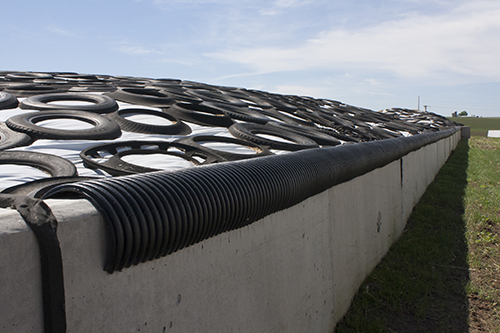
Haste makes waste. An idiom that's long been applied to children completing their household chores is just as relevant to our corn silage harvest and storage. Occasionally, in the haste to stay ahead of dry matter losses or impending weather, corners are cut. But this is a double-edged sword. These shortcuts may get the crop under plastic and tires sooner, while inadvertently causing irreversible dry matter losses.
At the Penn State Dairy Nutrition Conference, John Goeser with Rock River Laboratory spoke on the fermentation process from onset to feed-out. Ideally, we want to utilize as many of our harvested tons as possible. Ultimately, this comes down to minimizing shrink.
"There are four stages to the preservation process: aerobic, fermentation, stable and feed-out," noted Goeser. During the aerobic stage it is imperative to exclude as much oxygen as possible. "Lower oxygen levels yield a more efficient fermentation and preservation," he added. When it comes to the fermentation process, oxygen is the enemy.
Furthermore, we need to avoid extended fill situations as often as possible. Bacteria need enough fuel to drive fermentation. Rained on or weather-damaged forage may be limited in the amount of fuel it can provide for fermentation.
"Put your decision maker on the pack tractor or bagger. This is the person who needs to watch forages and make adjustments along the harvest chain, as necessary," Goeser said.
After sealing, the fermentation phase can last for several days to a month. At this point, microbes consume carbohydrates while producing acids and other compounds. "During fermentation, we need to grow the right bacteria, quickly. If we don't use a fermentation aid, we have no idea what bacteria or components will drive fermentation. In the best case scenario, we'll end up with only 2 to 3 percent shrink," Goeser added.
We can reduce some shrink with fermentation management. "Seepage can represent as much as 10 percent of our total dry matter losses," he noted. Meanwhile, primary and secondary fermentation can account for anywhere between 3 percent of losses in well managed forages and 25 percent of harvested tons when poor practices are in place.
Silage enters a stable phase until the forage's pH or anaerobic nature is compromised. Feed-out is one event that introduces oxygen back into the forage. At feed-out, it is important to limit aerobic exposure and maintain the silage's density.
Out of sight, out of mind is rarely a good philosophy under which to operate. When we're depending on the harvested tons to feed our herd for the next year, there's no room for dry matter losses that could have been avoided.

The author, Amanda Smith, was an associate editor and an animal science graduate of Cornell University. Smith covers feeding, milk quality and heads up the World Dairy Expo Supplement. She grew up on a Medina, N.Y., dairy, and interned at a 1,700-cow western New York dairy, a large New York calf and heifer farm, and studied in New Zealand for one semester.








